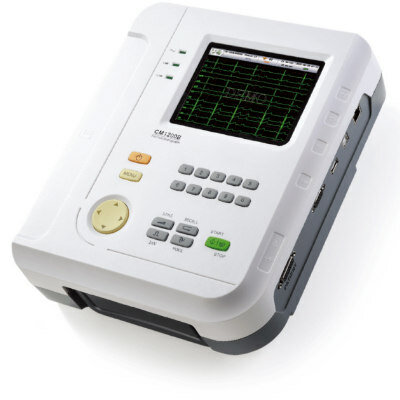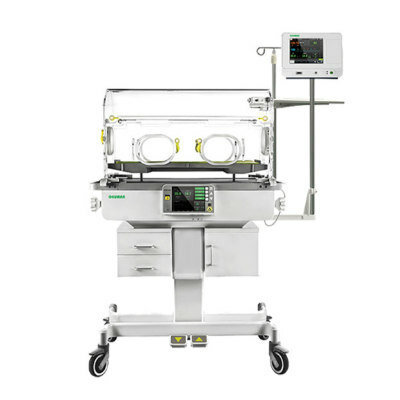Technological Advances to Fuel EHR-EMR Market Growth
|
By HospiMedica International staff writers Posted on 01 Oct 2018 |

Image: The global EHR-EMR market is expected to grow to USD 120 billion by the end of 2023 (Photo courtesy of OpenPR).
The global EHR-EMR market is expected to grow at a CAGR of 10.9% from USD 70 billion in 2016 to USD 120 billion by the end of 2023, driven primarily by an increase in the volume of medical records which requires proper management and storage. These are the latest findings of Market Research Future (Pune, Maharashtra, India), a market research company.
The global EHR-EMR market is proliferating due to the advantages of better accessibility, improved communication, data aggregation, integration, and lower staffing requirements which reduce health care costs as well as the scope for human errors. Technological advancements in EHR-EMR technology such as Blockchain, Byod, Artificial Intelligence, Opensource are also fueling the market growth. Additionally, cloud-based solutions are also providing growth opportunities. Small healthcare providers who are unable to afford upfront investments are opting for free and web-based services, which also eliminates the need for infrastructure and maintenance.
Government funding is a key driver of the global EHR-EMR market. Governments in various economies are funding projects to automate health record systems, thereby driving the demand for EHR-EMR. The growth of the healthcare and life sciences industry is also contributing to the growth of the EHR-EMR market.
Geographically, the Americas dominates the global EHR-EMR market due to the broad adoption of EHR-EMR, presence of major players and growth in the number of services among hospitals in the region. Europe is the world’s second-largest EHR-EMR market due to the growing adoption of IT in the healthcare sector for patient administration and engagement. Asia Pacific is expected to emerge as the fastest growing EHR-EMR market in the world, driven by the escalated demand for software solutions in the healthcare sector and growing expenditure on healthcare facilities in the region’s developing economies.
However, several factors are expected to restrict the growth of the global EHR-EMR market. For instance, the global economic slowdown resulting in lack of capital and operational constraints is likely to affect the market growth. There is high interest among both the developed and developing countries in automating health records, although the insufficient availability of technology to support the systems and lack of funds to migrate from existing systems to electronic systems are acting as constraints to the introduction of EHR-EMR systems in these economies.
The high cost involved in implementing EHR-EMR systems is a key factor limiting the market growth. Switching to EHR-EMR requires computers, electrical wiring and a large amount of electricity supply, all of which involves huge costs. Health administrators and governments are resistant towards adopting EHR-EMR systems due to the high implementation costs. Additionally, the lack of skilled staff having adequate knowledge of computers and disease classification, resistance among medical professionals to switch to an electronic system and change their behaviors and attitudes, and lack of data processing facilities are acting as barriers to the implementation of EHR-EMR.
Related Links:
Market Research Future
The global EHR-EMR market is proliferating due to the advantages of better accessibility, improved communication, data aggregation, integration, and lower staffing requirements which reduce health care costs as well as the scope for human errors. Technological advancements in EHR-EMR technology such as Blockchain, Byod, Artificial Intelligence, Opensource are also fueling the market growth. Additionally, cloud-based solutions are also providing growth opportunities. Small healthcare providers who are unable to afford upfront investments are opting for free and web-based services, which also eliminates the need for infrastructure and maintenance.
Government funding is a key driver of the global EHR-EMR market. Governments in various economies are funding projects to automate health record systems, thereby driving the demand for EHR-EMR. The growth of the healthcare and life sciences industry is also contributing to the growth of the EHR-EMR market.
Geographically, the Americas dominates the global EHR-EMR market due to the broad adoption of EHR-EMR, presence of major players and growth in the number of services among hospitals in the region. Europe is the world’s second-largest EHR-EMR market due to the growing adoption of IT in the healthcare sector for patient administration and engagement. Asia Pacific is expected to emerge as the fastest growing EHR-EMR market in the world, driven by the escalated demand for software solutions in the healthcare sector and growing expenditure on healthcare facilities in the region’s developing economies.
However, several factors are expected to restrict the growth of the global EHR-EMR market. For instance, the global economic slowdown resulting in lack of capital and operational constraints is likely to affect the market growth. There is high interest among both the developed and developing countries in automating health records, although the insufficient availability of technology to support the systems and lack of funds to migrate from existing systems to electronic systems are acting as constraints to the introduction of EHR-EMR systems in these economies.
The high cost involved in implementing EHR-EMR systems is a key factor limiting the market growth. Switching to EHR-EMR requires computers, electrical wiring and a large amount of electricity supply, all of which involves huge costs. Health administrators and governments are resistant towards adopting EHR-EMR systems due to the high implementation costs. Additionally, the lack of skilled staff having adequate knowledge of computers and disease classification, resistance among medical professionals to switch to an electronic system and change their behaviors and attitudes, and lack of data processing facilities are acting as barriers to the implementation of EHR-EMR.
Related Links:
Market Research Future
Latest Health IT News
- Machine Learning Model Improves Mortality Risk Prediction for Cardiac Surgery Patients
- Strategic Collaboration to Develop and Integrate Generative AI into Healthcare
- AI-Enabled Operating Rooms Solution Helps Hospitals Maximize Utilization and Unlock Capacity
- AI Predicts Pancreatic Cancer Three Years before Diagnosis from Patients’ Medical Records
- First Fully Autonomous Generative AI Personalized Medical Authorizations System Reduces Care Delay
- Electronic Health Records May Be Key to Improving Patient Care, Study Finds
- AI Trained for Specific Vocal Biomarkers Could Accurately Predict Coronary Artery Disease
- First-Ever AI Test for Early Diagnosis of Alzheimer’s to Be Expanded to Diagnosis of Parkinson’s Disease
- New Self-Learning AI-Based Algorithm Reads Electrocardiograms to Spot Unseen Signs of Heart Failure
- Autonomous Robot Performs COVID-19 Nasal Swab Tests

- Statistical Tool Predicts COVID-19 Peaks Worldwide
- Wireless-Controlled Soft Neural Implant Stimulates Brain Cells
- Tiny Polymer Stent Could Treat Pediatric Urethral Strictures
- Human Torso Simulator Helps Design Brace Innovations
- 3D Bioprinting Rebuilds the Human Heart
- Nanodrone Detects Toxic Gases in Hazardous Environments
Channels
Artificial Intelligence
view channel
AI-Powered Algorithm to Revolutionize Detection of Atrial Fibrillation
Atrial fibrillation (AFib), a condition characterized by an irregular and often rapid heart rate, is linked to increased risks of stroke and heart failure. This is because the irregular heartbeat in AFib... Read more
AI Diagnostic Tool Accurately Detects Valvular Disorders Often Missed by Doctors
Doctors generally use stethoscopes to listen for the characteristic lub-dub sounds made by heart valves opening and closing. They also listen for less prominent sounds that indicate problems with these valves.... Read moreCritical Care
view channel
Deep-Learning Model Predicts Arrhythmia 30 Minutes before Onset
Atrial fibrillation, the most common type of cardiac arrhythmia worldwide, affected approximately 59 million people in 2019. Characterized by an irregular and often rapid heart rate, atrial fibrillation... Read more
Breakthrough Technology Combines Detection and Treatment of Nerve-Related Disorders in Single Procedure
The peripheral nervous system (PNS) serves as the communication network that links the brain and spinal cord to every other part of the body. It consists of two parts: the somatic nervous system, which... Read moreSurgical Techniques
view channel
Hydrogel-Based Miniaturized Electric Generators to Power Biomedical Devices
The development of engineered devices that can harvest and convert the mechanical motion of the human body into electricity is essential for powering bioelectronic devices. This mechanoelectrical energy... Read moreWearable Technology Monitors and Analyzes Surgeons' Posture during Long Surgical Procedures
The physical strain associated with the static postures maintained by neurosurgeons during long operations can lead to fatigue and musculoskeletal problems. An objective assessment of surgical ergonomics... Read more.jpg)
Custom 3D-Printed Orthopedic Implants Transform Joint Replacement Surgery
The evolving field of 3D printing is revolutionizing orthopedics, especially for individuals requiring joint replacement surgeries where traditional implants fail to provide a solution. Although most people... Read more
Cutting-Edge Imaging Platform Detects Residual Breast Cancer Missed During Lumpectomy Surgery
Breast cancer is becoming increasingly common, with statistics indicating that 1 in 8 women will develop the disease in their lifetime. Lumpectomy remains the predominant surgical intervention for treating... Read morePatient Care
view channel
Surgical Capacity Optimization Solution Helps Hospitals Boost OR Utilization
An innovative solution has the capability to transform surgical capacity utilization by targeting the root cause of surgical block time inefficiencies. Fujitsu Limited’s (Tokyo, Japan) Surgical Capacity... Read more
Game-Changing Innovation in Surgical Instrument Sterilization Significantly Improves OR Throughput
A groundbreaking innovation enables hospitals to significantly improve instrument processing time and throughput in operating rooms (ORs) and sterile processing departments. Turbett Surgical, Inc.... Read more
Next Gen ICU Bed to Help Address Complex Critical Care Needs
As the critical care environment becomes increasingly demanding and complex due to evolving hospital needs, there is a pressing requirement for innovations that can facilitate patient recovery.... Read moreGroundbreaking AI-Powered UV-C Disinfection Technology Redefines Infection Control Landscape
Healthcare-associated infection (HCAI) is a widespread complication in healthcare management, posing a significant health risk due to its potential to increase patient morbidity and mortality, prolong... Read moreHealth IT
view channel
Machine Learning Model Improves Mortality Risk Prediction for Cardiac Surgery Patients
Machine learning algorithms have been deployed to create predictive models in various medical fields, with some demonstrating improved outcomes compared to their standard-of-care counterparts.... Read more
Strategic Collaboration to Develop and Integrate Generative AI into Healthcare
Top industry experts have underscored the immediate requirement for healthcare systems and hospitals to respond to severe cost and margin pressures. Close to half of U.S. hospitals ended 2022 in the red... Read more
AI-Enabled Operating Rooms Solution Helps Hospitals Maximize Utilization and Unlock Capacity
For healthcare organizations, optimizing operating room (OR) utilization during prime time hours is a complex challenge. Surgeons and clinics face difficulties in finding available slots for booking cases,... Read more
AI Predicts Pancreatic Cancer Three Years before Diagnosis from Patients’ Medical Records
Screening for common cancers like breast, cervix, and prostate cancer relies on relatively simple and highly effective techniques, such as mammograms, Pap smears, and blood tests. These methods have revolutionized... Read morePoint of Care
view channel
Critical Bleeding Management System to Help Hospitals Further Standardize Viscoelastic Testing
Surgical procedures are often accompanied by significant blood loss and the subsequent high likelihood of the need for allogeneic blood transfusions. These transfusions, while critical, are linked to various... Read more
Point of Care HIV Test Enables Early Infection Diagnosis for Infants
Early diagnosis and initiation of treatment are crucial for the survival of infants infected with HIV (human immunodeficiency virus). Without treatment, approximately 50% of infants who acquire HIV during... Read more
Whole Blood Rapid Test Aids Assessment of Concussion at Patient's Bedside
In the United States annually, approximately five million individuals seek emergency department care for traumatic brain injuries (TBIs), yet over half of those suspecting a concussion may never get it checked.... Read more















